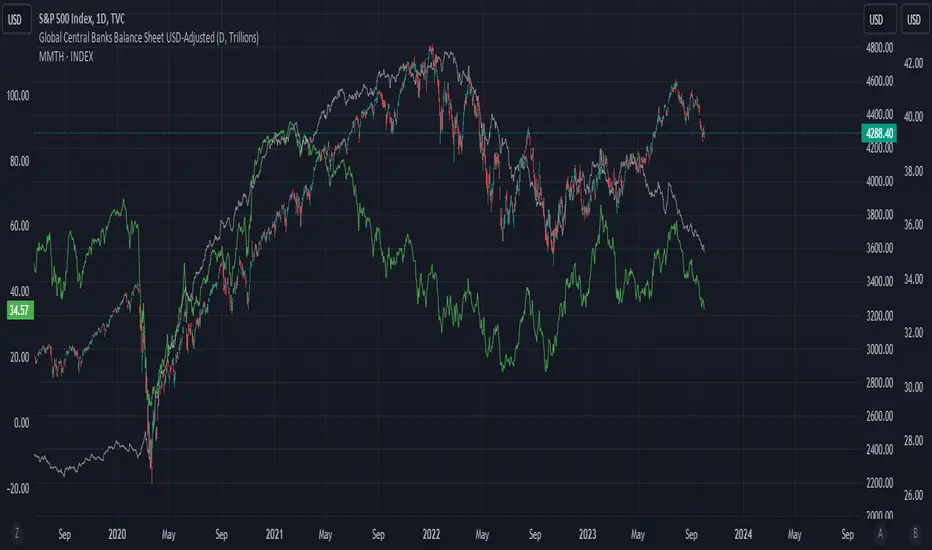OPEN-SOURCE SCRIPT
更新済 Global Central Banks Balance Sheet USD-Adjusted

Summing up central banks balance sheet of:
US , China, EU, Japan, UK,
Swiss, Australia, Canada, Norway
Brazil, Russia, India, Mexico, Indonesia
Taiwan, HK, Korea, SG, Thailand
Then adjusting it to USD as the common denominator for comparison.
Net Foreign Assets (or foreign reserves) + Net Domestic Assets (or domestic credit, usually Money Supply M1) = Total Assets of the Central Bank Balance Sheet
In some way, the central bank balance sheet could be M2. However, I find some of the indicators don't add up and I don't have the time to check them out. This indicator is just a proxy. The issue with using central bank balance sheet to determine liquidity in the system is that it doesn't account for 1) collateral used for liquidity management in the public and private system, 2) shadow-banking financial system. As usual, US + EU + Japan publishes their data every weekly and the rest of the central banks publish monthly. I have removed any country with hard-pegged currencies except HK.
Additional materials to aid understanding:
imf.org/-/media/Files/News/Seminars/2017/macroeconomist-training-program-011118/session-2-1.ashx
US , China, EU, Japan, UK,
Swiss, Australia, Canada, Norway
Brazil, Russia, India, Mexico, Indonesia
Taiwan, HK, Korea, SG, Thailand
Then adjusting it to USD as the common denominator for comparison.
Net Foreign Assets (or foreign reserves) + Net Domestic Assets (or domestic credit, usually Money Supply M1) = Total Assets of the Central Bank Balance Sheet
In some way, the central bank balance sheet could be M2. However, I find some of the indicators don't add up and I don't have the time to check them out. This indicator is just a proxy. The issue with using central bank balance sheet to determine liquidity in the system is that it doesn't account for 1) collateral used for liquidity management in the public and private system, 2) shadow-banking financial system. As usual, US + EU + Japan publishes their data every weekly and the rest of the central banks publish monthly. I have removed any country with hard-pegged currencies except HK.
Additional materials to aid understanding:
imf.org/-/media/Files/News/Seminars/2017/macroeconomist-training-program-011118/session-2-1.ashx
リリースノート
oreilly.com/library/view/central-bank-balance/9781547400591/content/13_chapter03.xhtmlyardeni.com/pub/balsheetwk.pdf
ECB, Fed and BOJ updates weekly. The rest is monthly or annually.
リリースノート
Changed the intro chart back to SPX vs market breadth vs this indicatorリリースノート
-オープンソーススクリプト
TradingViewの精神に則り、この作者はスクリプトのソースコードを公開しているので、その内容を理解し検証することができます。作者に感謝です!無料でお使いいただけますが、このコードを投稿に再利用する際にはハウスルールに従うものとします。
免責事項
これらの情報および投稿は、TradingViewが提供または保証する金融、投資、取引、またはその他の種類のアドバイスや推奨を意図したものではなく、またそのようなものでもありません。詳しくは利用規約をご覧ください。
オープンソーススクリプト
TradingViewの精神に則り、この作者はスクリプトのソースコードを公開しているので、その内容を理解し検証することができます。作者に感謝です!無料でお使いいただけますが、このコードを投稿に再利用する際にはハウスルールに従うものとします。
免責事項
これらの情報および投稿は、TradingViewが提供または保証する金融、投資、取引、またはその他の種類のアドバイスや推奨を意図したものではなく、またそのようなものでもありません。詳しくは利用規約をご覧ください。